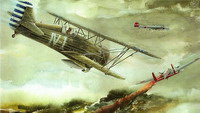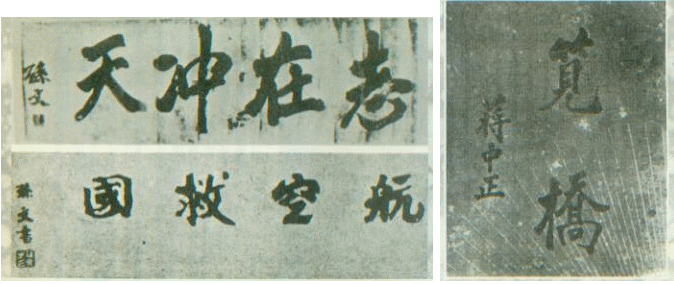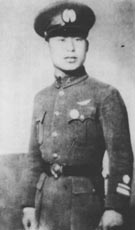
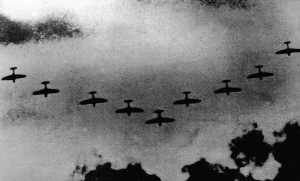

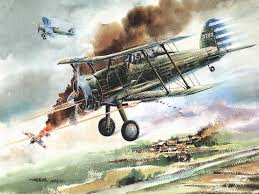
首創八一四空戰大捷的空軍戰神 .高志航大隊長首戰擊落日本轟炸機六架,創下中日空戰全勝紀錄,打破了「皇軍無敵」的神話。 一九三七年八月十四日清晨,中國空軍主動對黃埔江上的日本海軍艦艇發動攻擊,日軍盛怒下立刻調動從台灣飛來的木更津聯隊與鹿屋聯隊戰鬥機,企圖一舉消滅南京、上海地區之所有中國空軍基地。不料當天入侵的日本機群,遭到中國空軍第四大隊長高志航率領的戰機反擊,結果中國空軍以六比零擊落日機,首開中日空戰全勝紀錄,打破了「皇軍無敵」的神話。https://youtu.be/Wh0hpRaY2j4
【中華民國空軍軍歌】曲:劉雪庵 / 詞:簡樸 (民國35年)
凌雲御風去,報國把志伸,
遨遊崑崙上空,俯瞰太平洋濱,
看五嶽三江雄關要塞,美麗的錦繡河山,輝映著無敵機群。
緬懷先烈莫辜負創業艱辛,發揚光大尤賴我空軍軍人!
同志們努力努力,矢勇矢勤,國祚皇皇萬世榮。
盡瘁為空軍,報國把志伸,
那怕風霜雨露,只信雙手萬能,
看鐵翼蔽空馬達齊鳴,美麗的錦繡河山,輝映著無敵機群。
我們要使技術發明日日新,我們要用血汗永固中華魂。
同志們努力努力,同德同心,國祚皇皇萬世榮。
我們要使技術發明日日新,我們要用血汗永固中華魂。
同志們努力努力,同德同心,國祚皇皇萬世榮。
【中華民國空軍官校校歌】曲:劉雪庵 / 詞:簡樸 (民國35年)
得遂凌雲願,空際任迴旋,
報國懷壯志,正好乘風飛去,
長空萬里,還我舊河山,
努力,努力,莫偷閒苟安,
民族興亡責任待吾肩,
須具有犧牲精神, 平展雙翼,
一沖天!
八一四空戰,是中國抗日戰爭淞滬會戰期間,國民革命軍空軍和日本帝國陸軍戰機之間的一次空戰,時間發生在1937年8月14日,因而得名。
1937年(民國二十六年)8月14日,中華民國空軍飛上海作戰,曾炸日領事館及出雲號旗艦未中,然在瀏河則炸沉日艦一艘、傷四艘,中國飛機一架受傷
10時,中華民國空軍首次出動,轟炸虹口、滙山碼頭等處日軍據點。中國空軍轟炸日本海軍陸戰隊司令部,炸傷10餘艘日艦。
中國空軍抗擊日軍飛機空襲杭州筧橋的作戰。又稱“筧橋空戰”。
1937年“七七”盧溝橋抗戰爆發後,日軍發動全面侵華戰爭。8月13日,日軍以重兵向上海發動進攻(見淞滬會戰)。國民政府軍事委員會急令駐河南周家口的空軍第4驅逐機大隊調杭州,加強淞滬地區的防空力量。14日,第4大隊調防杭州筧橋機場剛著陸,未及加油,即遭日機空襲。大隊長高志航在飛機余油不多、氣象條件惡劣的情況下,毅然率領所屬3個中隊27架飛機緊急升空抗擊。
高志航駕駛“霍克”Ⅲ型驅逐機起飛後,先爬高至雲上,未見敵機,即下降至雲下,發現96式飛機1架,迅速逼近目標,連續兩次射擊,首開記錄,日機中彈墜毀。隨後又發現3架日機,便抓住機會迅速佔位瞄準攻擊,又擊落日機1架。與此同時,第21中隊中隊長李桂丹等人也發現2架日機,經連續攻擊,擊落、擊傷各1架。在空戰中,日機為躲避中國驅逐機的攻擊,時而鑽進雲中,時而降至雲層下。由於中國飛行員英勇頑強,緊追不捨,經約30分鐘激烈戰鬥,擊落日機3架、擊傷1架,中國空軍無一損傷。
此次空戰是中國空軍抗擊日軍空中襲擊的第一次作戰。首戰獲勝,給日軍以沉重打擊,極大地鼓舞了中國軍民抗日鬥志,增強了戰勝侵略者的信心。為紀念首次空戰勝利,國民政府將8月14日定為“空軍節”。
日方紀錄稱八一四當晚三架飛機未返回台北松山基地,經查證日方損失為
擊落二架: 一小隊三號機、三小隊三號機。
重傷二架: 三小隊二號機、二小隊二號機。
輕傷二架: 三小隊一號機中彈一發、發電機受損;一小隊一號機中彈一發。
中國方面:二十一分隊五號機劉樹籓油盡停車,墜落場外,機毀人亡。二分隊六號機金安一油盡停車迫降,機傷人微傷。
| 木更津海軍航空隊の開設まで |
|
|
|
満州事変後、中国大陸への進出を画策する軍部にあって、中国大陸への長距離飛行での空爆を企図し、同時に航空機による攻撃から首都防衛を考えていた海軍は、かねて東京湾沿岸の適地を選び、海軍航空隊を建設しようと考えていた。
東京湾沿岸の候補地は木更津・青堀・姉ヶ崎、行徳などとなっており、1934年(昭和9年)年頭には海軍省から千葉県知事にその旨の内示があり、木更津町長であった石川善之助らも海軍航空隊の誘致運動をはじめた。 すなわち、同年7月5日には石川町長の提唱にて、「木更津飛行場建設促進同盟会」が結成され、翌々日の7日には横須賀鎮守府建築部より測量要員6名が派遣されて現地測量が行われた。一方、木更津海軍飛行場の予定地であった巌根村中里・江川地区の漁民ら住民にとっては寝耳に水であり、また中里・江川地区の海岸の一部埋め立てによって漁業を行う場所が制約されるため建設反対の声があがった。しかし、「木更津飛行場建設促進同盟会」の実行委員らが説得し、7月中旬にはほぼ反対気運はおさまった。その後、7月20日に横須賀鎮守府より木更津町に海軍航空隊設置決定の通告があった。 |

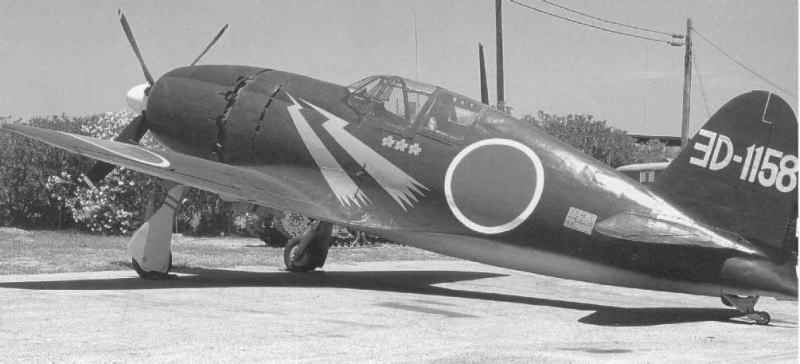 0.
0.
 Although the air battles between the Chinese and Japanese pilots above the sky of China from 1937 to 1941 was considered by Westerners a forgotten war, it was still too important for the people to deny. For the Japanese pilots, those were their first chance to earn experiences about fighting other pilots in the air. As for the Chinese pilots, those were absolutely deadly struggles for them to protect their motherland from the invaders.
Although the air battles between the Chinese and Japanese pilots above the sky of China from 1937 to 1941 was considered by Westerners a forgotten war, it was still too important for the people to deny. For the Japanese pilots, those were their first chance to earn experiences about fighting other pilots in the air. As for the Chinese pilots, those were absolutely deadly struggles for them to protect their motherland from the invaders.
Even for the Americans, it was their only chance to observe and learn about the planes and tactics used by their future enemy in the Pacific Theater. In order to understand how the war began, we should all look back on August 14, 1937 when everything started in Shanghai.
Creation of the Chinese Air Force

Chinese flying cadets with E. D. Shannon, probably at Hangchou
Officially, the Republic of China Air Force under the Chinese National Government was formed in April 1931 when the Chinese Aviation School was founded in Chienchiu near the city of Hangchou. For China, it was a chaotic period when the Central Government was facing both internal and external challenges. The Japanese had occupied Manchuria on September 18, 1931, and then soon was in conflict with the Chinese Army in Shanghai on January 28, 1932. Flying early aircraft such as Junkers K-47 built by Germany, Blackburn Lincock built by Great Britain and Waco 240A built by the United States of America, the Chinese Air Force took off and began their first limited air war with the Japanese. Unfortunately, this war ended too fast before the Chinese pilots had any chance to shoot down Japanese planes. Notice that alone American pilot named Robert Short flying a Boeing 218 biplane, attacked a Japanese bomber formation from aircraft carrier Kagaon February 22, and killed their officer. Then Short was shot down and killed by the Japanese, but he was still considered the very first pilot who took action against the Japanese invaders in the sky of China.
After the First Shanghai incident ended, the Chinese Nationalist government realized it was time for them to reform its air force to prepare for future conflict with the Japanese. The first step Chiang Kai-Shek took was to hire a group of American advisors consisting of 17 men led by retired Major John H. Jouett of the United States Army Air Corps. Their mission was to create a modern Chinese Air Force with the American system.
On September 1, 1932, the Chinese Aviation School was renamed Central Aviation School, which is considered the first time for China to have a national aviation school against those formed in different provinces by various warlords. In 1933, the Chinese also hired Roberto Lordi to lead a group of Italian advisors to train Chinese pilots at the Luoyang Campus of the Central Aviation School. By this time, there were both American and Italian training systems inside the Chinese Air Force, which later brought many problems in the early phase of the war.
Beside the external challenge brought to China by the Imperial Japanese Army, the Chinese Central Government faced various internal problems. For China's top leaders during that period, the threat of Japan was really like a "problem of the skin" compared to the challenges from different local warlords and Communists, who were considered the "problem of the heart" by Generalissimo Chiang Kai-Shek. In some points, this kind of concern was true for China because it obstructed the Central Government effort to form a united national military force to defend China from any outside invaders.

American-built Fleet trainer of the Chinese Air Force
China never had a united air force until 1936 when the pilots from Canton and Kwangsi Provinces defected to Nanking, the Nationalist capital.After that, the Chinese finally had a chance to establish the Central Aviation Committee to organize and command all Chinese air force units. Madame Chiang Kai-Shek became Secretary of the Aviation Committee, while General Chou Chih-Jou was appointed the Chief Advisor. With this process, the Chinese Air Force became totally under the Generalissimo control.
Chiang Kai-Shek and the Chinese Communist Party temporarily agreed to unite against the Japanese. Full-scale war between China and Japan began even though both sides refused to declare war officially against each other, on July 7, 1937, in Peiping (Beijing).
After the war outbreak, the Chinese Air Force consisted of 9 Groups and 4 independent squadrons (each squadron with 9 aircraft). When the Chinese 29th Army began to resist the Japanese Army in North China, the Chinese Nationalist soon ordered all flight units to get ready to fly ground support missions for the army in the North. The 2nd Bomb Group with Northrop Gamma light bombers and the 4th Pursuit Group with Curtis Hawk-III biplanes soon moved to Chou Chia-Kou Air Base in Honan Province. By this time, all the Chinese pilots were waiting for their first chance to show the Japanese what they had prepared for those years.
Japanese war plans
While the Japanese Army advanced in the North, Japanese marines in Shanghai were also in conflict with the Chinese Nationalist Army. But this time, they were facing Chiang Kai-Shek's best forces, three divisions of Chinese Central Government Army trained by the German advisors. On August 13, 1937, the leaders of both nations realized that they were in a war of no return that was far different from any limited clashes they had before in Manchuria, North China and Shanghai.
Now the Chinese decided to fight a major battle to defend this international city of Shanghaiin order to attract the attention from the international community in the hope that other nations would eventually pressure the Japanese to give up their ambition. As for the Japanese, they planned to punish the Chinese resisting the Japanese Empire. They claimed that they would capture Shanghai and force China to submission in three months. While the Japanese Army was fighting in the North, the Japanese Navy was in charge of the fighting in Central China.
The Japanese Navy Air Force realized that the Japanese troops in Shanghai were outnumbered by the Chinese regular troops in that area. With the air support provided by the Chinese Air Force from Nanking and other air bases located in the coastal areas, the attempt by the Japanese marines to hold up the Nationalist Chinese troops would eventually fail. In order to prevent the Chinese army from wiping the Japanese out, the primary goal for the Imperial Japanese Navy Air Force was to totally destroy the resistant morale by the air supremacy.
Since the Japanese had not developed any airfields in Shanghai yet, there were only two options they could use to fulfill their mission. When the Japanese realized the Chinese Army's 87th and 88th Divisions were moving into Shanghai on August 11, they ordered two light aircraft carriers, Hosho and Ryujo, to form up the 1st Carrier Division under the command of the 3rd Fleet (with the cruiser Izumo as its flagship). They left the port of Sasebo next day for the Ma-An-Shan Islands area, 132 kilometers east from Shanghai, to prepare for their mission.
At the same time, the heavy aircraft carrier Kaga was also escorting transports carrying army units to reinforce the Japanese Marines. Aboard Kaga, there were 16 Mitsubishi B2M2 attack aircrafts, 13 Yokosuka B3Y attack aircrafts, 14 Aichi D1A1 dive bombers and 16 Nakajima A2N carrier fighters. The missions for the carrier-based aircraft were to destroy the Chinese air bases in the coastal areas, while providing air support for the Japanese ground force.
Beside the aircraft carriers, the Japanese also used their colonies such as Formosa and Korea to conduct "transoceanic bombing" against the inland Chinese air bases. The Kanoya Kokutai's bomber daitai (Group), with 18 Mitsubishi G3M Model 21 long-range bombers under Lieutenant Nitta's command, was integrated into the 1st Rengo Konutai and advanced to Matsuyama airfield located in Taihoku (now Taipei), Formosa. With the lesson learned from the Spanish Civil War, the target for their strategic bombing missions would also include Chinese cities and traffic facilities. It was certainly the way how the Japanese believed that they could end the war sooner by scaring the Chinese soldiers and civilians to surrender themselves to the "benevolent" Japanese Empire, instead of being used unwisely by the "brutal" Chinese Nationalist Government.
Chinese Air Force response

CAF Northrop 2-E with the Chinese Nationalist roundels
Realizing full-scale war with Japan was inevitable, the Aviation Committee of the Chinese Nationalist Government issued Order No. 1 to modify their original battle plans on August 13. With this order, Shanghai areas now replaced North China to become the major battlefield for the Chinese Air Force. The 2nd Bomb Group, 4th Pursuit Group, and 5th Pursuit Group were ordered to move to Tsining, Chienchiu and Yangchow before noon on August 14. In the Central Aviation School of Chienchiu, the instructors and cadets were also ordered to establish three provisional squadrons: 32nd (bomb), 34th (Pursuit) and 35th (bomb). These became the first Chinese air units to confront the Japanese in the Shanghai areas. Instead of fighting a defensive war, the Chinese Air Force immediately issued Order No. 2 on Saturday, August 14, and it directed all the air units in the Eastern China bases to launch attacks on the Japanese positions in Shanghai. Besides fighting the Japanese, the Chinese pilots would also have to face a huge typhoon that was striking the city on the same day.
The first air raid took place around 8:40 in the morning, when 21 Northrop Gamma 2E bombers led by Commander Sun Tong-Gang attacked the Japanese ships at Wusong.After that, the Kuang-Ta Cotton Factory, where the Japanese command post located, was under heavy attacks as well by both Chinese planes and Chinese soldiers. The Chinese certainly wanted to drive the Japanese out from the city by occupying this building.
Using Hawk III biplanes as both bombers and fighters, 8 planes (each with one 250 kg bomb) of the 5th Pursuit Group under the command of Ting Chi-Hsu took off from Yangchow to launch the second wave of attack against the Japanese ships near Nantong. During this attack, Lt. Liang Hong-Wen in Hawk III # 2401 was credited with a hit on the stern of a "Japanese" ship. The Chinese was actually attacking the British cruiser Cumberland, and instead of hitting it, the Chinese pilots near missed it. Visibility was terribly bad that day. Two bombs also exploded near USS Augusta(CA-31), an American cruiser from the Asiatic Fleet, but fortunately no one was killed.
In the afternoon, the Chinese Air Force attacked again. This time under Commander Liu Chui-Kang, three Hawk IIIs from the 24th Squadron of 5th Group again attacked the Ta-Kuang Cotton Factory. This time, a bigger accident occurred when the Chinese pilot accidentally dropped a bomb on Nanking Road of the International Settlement. Eventually Shanghai suffered over 1700 civilians dead and 1800 others wounded.
According to the American advisor, Claire Lee Chennault, the Chinese pilots were trained to bomb from 7500 feet, but with the thick clouds blocking their vision in the sky, they were forced to drop the bombs from a lower altitude. Without adjusting their bombsights, the Chinese dropped their bombs at 1500 feet. The young Chinese pilots were too simply inexperienced to make the kind of adjustment for accurate bombing under the difficult circumstance. The result was a terrible disaster.
To compound their trouble, the Japanese Navy launched two Type 95 floatplanes to intercept the Chinese. Using the thick cloud as cover, one floatplane from the light cruiser Sendai attacked the 24th Squadron. The Hawk III flown by Lt. Liang Hong-Wen was damaged and made a forced landing. He later died of his injuries. Later in the afternoon, another floatplane from Izumoattacked Northrop 2E bombers from the 2nd Bomb Group. Lt. Chu Hong-Hsin was wounded in the arm while his gunner Lt. Ren Yun-Ge was hit in the chest and killed. The damaged Northrop managed to limp back to Hong-Chiao Airfield for forced landing.
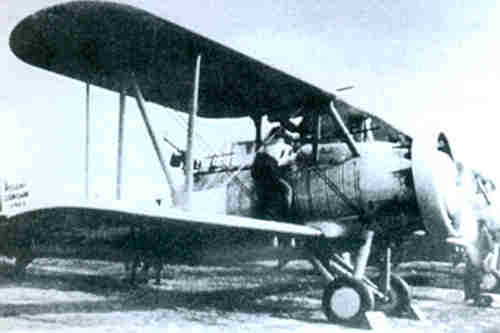
CAF Chance-Vought V-92C Corsair
With all those accidents, the young Chinese pilots continued to carry out their missions. By 14:40, three Chance Vought V-92C Corsairs of the 35th Squadron (provisional) appeared in the sky of Shanghai. Led by Squadron Commander Hsu Si-Lian, they provided the air support for the Chinese 87th Division to attack the Kuang-Ta Factory. Following that, five Hawk IIs and one Hawk III led by Captain Chow Ting-Fang attacked the same target. The Japanese floatplane which had damaged the Northrop as described earlier was attacked in turn by the 34th Provisional Squadron led by Chow Ting-Fang. The Japanese plane was hit 15 times and damaged before it was able to escape into cloud cover.
The Battle of Shanghai marked the first time Chinese Central Army enjoyed close air support from the air force. Unfortunately, due to difficult with ground-air communication and the general lack of experience coordinating close air support missions, the result left much to be desired. The Kuang-Ta Cotton Factory was never taken back by the Chinese soldiers. Although the Chinese had failed to drive the Japanese out before the Japanese reinforcement arrived, the Chinese Air Force was able to receive its first victory against the Japanese Navy Air Force bombers began attacking the Chinese bases.





